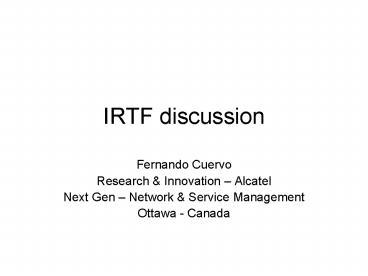IRTF discussion PowerPoint PPT Presentation
1 / 16
Title: IRTF discussion
1
IRTF discussion
- Fernando Cuervo
- Research Innovation Alcatel
- Next Gen Network Service Management
- Ottawa - Canada
2
What Services Concise Service Model
- IP best effort or differentiated
- Ethernet PW and VPLS
- QoS Pipes
- Grid
- Interactive media
- Multicast
- Fat Hour-Glass
- Non transparent function
- Load balancing
- Firewall awareness
3
Management Principles
- good management is NO management
- build services on infrastructure with good
management attributes - restoration
- fault localisation
- automated features (address allocation, service
location) - dont restore what can be easily rebuilt
- Clean up right away
- User controlled (Canarie UCLP)
- Application saves state
- learn to deal with non-unified data or info
models - Manage the goals, not the configurations
- Goals, roles
- learn to use incomplete/imprecise information
- judge information on their relation to
- How is it used to derive the state of
organisation in the network - Does it become stale, inconsistent, how?
4
How to address Management Complexity
- Self Management (if advantageous to self )
- User independent (Prepaid)
- Implementation independent (DSCP)
- Do it in the control plane or in a control plane
like manner (looser time-space - same approach) - Build fewer and wider layers
- Layering is the easy way to deal with complexity
- It is increasingly easier to build silos
- Name things consistently
- Device Auto-configuration (DSL Automation)
- Dynamic service configuration (DSL multicast
distribution) - Policy (large classes of objects with a certain
behaviour)
5
Topic 1 Policy
- Role Capability Management
- Policy Control
- Policy representation execution
- What it solves
- Scalability of the Manager-Agent architecture
- Centralisation -gtlack of flexibility
6
Policy Control Model
Dealing with Information (Policies or
Configuration)
Supports this
Much better way to do this
Putting/Removing/Modifying info in the Network
How Much impact on This is acceptable
Network
Move from Push to Pull
7
Overview of Pull
Learn from where to acquire the configuration to
perform the Role (if not known)
Device has capabilities and is instructed of
roles that it may perform
Pull configuration in
Device learns from the environment, decides the
roles that it will perform
8
Top-Down management process
Service Request
Service Design
Service Configuration
Service Activation
Management Layer
B
C
A
D
9
Pull based process
Role Instantiation and removal
Service Activation
Management Layer
B
Service Request
Notification
C
A
service set up
D
10
Key Pull enablers
- service smarts in the network
- SIP, LDP like mechanisms
- self-organisation of roles in the network
- Reduced role of manager tracking role instances,
location of roles. - Scalability attributes
11
A proposal for Self-Organisation
12
Advantages of the Proposal
- Manager does not need to keep track of who
implements the roles. - Tree organisation is scalable
- Easier to verify and instigate completion of a
request. - Management infrastructure is dynamic
- Local variations of the role handled by sub-trees
- Activation centralisation is gone.
13
Topic 2 Transparency management
- Two issues
- advertise/discover what the network is doing
- How to configure the functionality to achieve the
users desired service.
14
Topic 2 Transparency management
Service Function
Service Function
Service end
Middleboxes
Service end
Service Function Registration Proxy,
Authentication, Policy,..
15
Types of services
- Transparent
- end-points need only a point of presence in the
network. - Middlebox aware
- End points view the service as enabled or
impaired by what it finds or it doesnt in a
network
16
Transparency Framework
- Dependencies between managed service types and
middlebox functions - Mechanism for services-ends discover/learn the
middlebox functions and apply on configuration - Model for service functions and service ends
cooperate - Can a service function understand the middle-box
functions and abstract those in a behaviour
directive towards the services? - Management characteristics of service functions
- Belong to network operator?
- Are they cross domain?
- Belong to the service provider?
- Belong to the service user community?

